品牌转换模型分析
22种盈利模型
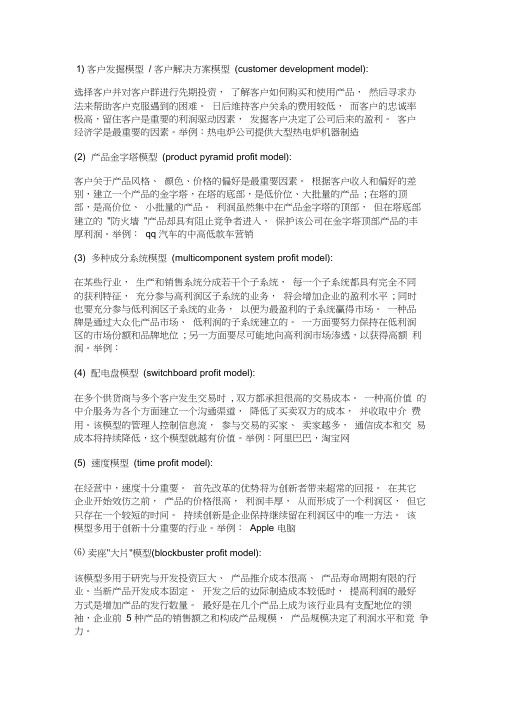
1) 客户发掘模型/ 客户解决方案模型(customer development model):选择客户并对客户群进行先期投资,了解客户如何购买和使用产品,然后寻求办法来帮助客户克服遇到的困难。
日后维持客户关系的费用较低,而客户的忠诚率极高,留住客户是重要的利润驱动因素,发掘客户决定了公司后来的盈利。
客户经济学是最重要的因素。
举例:热电炉公司提供大型热电炉机器制造(2) 产品金字塔模型(product pyramid profit model):客户关于产品风格、颜色、价格的偏好是最重要因素。
根据客户收入和偏好的差别,建立一个产品的金字塔,在塔的底部,是低价位、大批量的产品; 在塔的顶部,是高价位、小批量的产品。
利润虽然集中在产品金字塔的顶部,但在塔底部建立的"防火墙"产品却具有阻止竞争者进入,保护该公司在金字塔顶部产品的丰厚利润。
举例:qq 汽车的中高低款车营销(3) 多种成分系统模型(multicomponent system profit model):在某些行业,生产和销售系统分成若干个子系统,每一个子系统都具有完全不同的获利特征,充分参与高利润区子系统的业务,将会增加企业的盈利水平; 同时也要充分参与低利润区子系统的业务,以便为最盈利的子系统赢得市场。
一种品牌是通过大众化产品市场、低利润的子系统建立的。
一方面要努力保持在低利润区的市场份额和品牌地位; 另一方面要尽可能地向高利润市场渗透,以获得高额利润。
举例:(4) 配电盘模型(switchboard profit model):在多个供货商与多个客户发生交易时, 双方都承担很高的交易成本。
一种高价值的中介服务为各个方面建立一个沟通渠道,降低了买卖双方的成本,并收取中介费用。
该模型的管理人控制信息流,参与交易的买家、卖家越多,通信成本和交易成本将持续降低,这个模型就越有价值。
举例:阿里巴巴,淘宝网(5) 速度模型(time profit model):在经营中,速度十分重要。
市场调查常用模型

TNS模型学习心得交流焦永刚//360茶社//3月19日//七层会议室模型简述:主要的应用领域帮助客户发现产品品类或子品牌的未来市场机会和威胁,是一种能够为客户带来附加价值的前瞻性(foresight )分析工具,而不是专门的细分或预测模型,通常作为一种附加服务放在一个整体性的研究之中。
FutureView™快速消费品行业为主,尤其是包含很多产品品类或子品牌的快速消费品,比如食品饮料和日用品等,其次涉及电子产品、汽车、金融产品等领域。
客户所在的主要行业 3. 未来市场机会地图(FOM: Future Opportunity Map )2. 市场机会指数(FOI: Future Opportunity Index )是最关键的指标1. 五类人群的细分: 用新消费主义者的七个理念设计20个问题,用来细分分析工具帮助客户找到市场的未来机会,尤其是发现产品、品类、品牌的未来机会,以及帮助客户进行新产品开发等:•哪些人群是对未来市场最具有影响力的人群?最值得重视的人群?•哪些产品品类或者怎样的新产品具有更好的未来增长机会而值得重点发展?应用价值产品品类和品牌资产研究Category and Brand Equity Studies市场细分:使用行为和态度Segmentation Studies Usage & Attitude新产品概念的形成Consumer Ideation新产品概念的筛选Concept ScreeningTRI*M Competitive Analysis :竞争优劣势分析TRI*M Grid :识别客户维系过程中的驱动因素TRI*M Index :测量一个企业客户维系能力的单值指数,可作全球对比。
TRI*M Typology (客户/员工类型):传道士,唯利是图者,人质,恐怖分子。
TRI*M 包括:Measuring, Managing, Monitoring 。
是指对利益相关者(客户、员工、股东等)之间的关系进行测量分析、采取措施改进、再进行过程监测的闭环管理过程。
波特五力模型案例分析之亚细亚
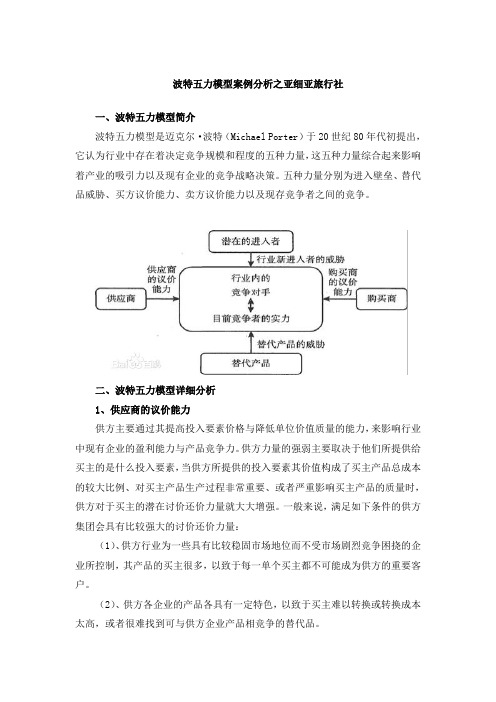
波特五力模型案例分析之亚细亚旅行社一、波特五力模型简介波特五力模型是迈克尔·波特(Michael Porter)于20世纪80年代初提出,它认为行业中存在着决定竞争规模和程度的五种力量,这五种力量综合起来影响着产业的吸引力以及现有企业的竞争战略决策。
五种力量分别为进入壁垒、替代品威胁、买方议价能力、卖方议价能力以及现存竞争者之间的竞争。
二、波特五力模型详细分析1、供应商的议价能力供方主要通过其提高投入要素价格与降低单位价值质量的能力,来影响行业中现有企业的盈利能力与产品竞争力。
供方力量的强弱主要取决于他们所提供给买主的是什么投入要素,当供方所提供的投入要素其价值构成了买主产品总成本的较大比例、对买主产品生产过程非常重要、或者严重影响买主产品的质量时,供方对于买主的潜在讨价还价力量就大大增强。
一般来说,满足如下条件的供方集团会具有比较强大的讨价还价力量:(1)、供方行业为一些具有比较稳固市场地位而不受市场剧烈竞争困挠的企业所控制,其产品的买主很多,以致于每一单个买主都不可能成为供方的重要客户。
(2)、供方各企业的产品各具有一定特色,以致于买主难以转换或转换成本太高,或者很难找到可与供方企业产品相竞争的替代品。
(3)、供方能够方便地实行前向联合或一体化,而买主难以进行后向联合或一体化。
(注:简单按中国说法,店大欺客)2、购买者的议价能力购买者主要通过其压价与要求提供较高的产品或服务质量的能力,来影响行业中现有企业的盈利能力。
其购买者议价能力影响主要有以下原因: (1)、购买者的总数较少,而每个购买者的购买量较大,占了卖方销售量的很大比例。
(2)、卖方行业由大量相对来说规模较小的企业所组成。
(3)、购买者所购买的基本上是一种标准化产品,同时向多个卖主购买产品在经济上也完全可行。
(4)、购买者有能力实现后向一体化,而卖主不可能前向一体化。
(注:简单按中国说法,客大欺主)3、新进入者的威胁新进入者在给行业带来新生产能力、新资源的同时,将希望在已被现有企业瓜分完毕的市场中赢得一席之地,这就有可能会与现有企业发生原材料与市场份额的竞争,最终导致行业中现有企业盈利水平降低,严重的话还有可能危及这些企业的生存。
用波特的“五力”模型全面分析耐克和阿迪达斯

从20世纪70年代开始,耐克就从一家产品导向的公司逐渐转变为一家市场导向的公司。它在全球范围内运营,在公司内部设计高技术和高品质的产品,在低成本的国家生产,再成功地通过营销建立起作为青少年亚文化标志的品牌。耐克的独特资源包括专利产品和商标、品牌声誉,公司文化和公司独特的人力资产。
2, 替代品的威胁:某一行业有时常会与另一行业的企业处于竞争的状况,其原因是这些企业的产品具有相互替代的性质。替代产品的价格如果比较低,它投入市场就会使本行业产品的价格上限只能处在较低的水平,这就限制了本行业的收益。本行业与生产替代产品的其它行业进行的竞争,常常需要本行业所有企业采取共同措施和集体行动。
首先,这个领域存在较高的进入壁垒。美国运动鞋产业由“不用工厂生产”的品牌型公司组成,大公司在广告、产品开发以及销售网络、出口方面都更有成本优势。更重要的是,品牌个性与消费者忠诚度都给潜在的进入者设置了无形的屏障。
其次,供应商的议价能力较弱。因为大多数运动鞋产业的投入都是同质的,特别是在耐克发起了外购浪潮后,超过90%的生产都集中在低工资、劳动力远远供过于求的国家。
5, 现有竞争者之间的竞争:这种竞争力量是企业所面队的最强大的一种力量,这些竞争者根据自己的一整套规划,运用各种手段(价格、质量、造型、服务、担保、广告、销售网络、创新等)力图在市场上占据有利地位和争夺更多的消费者,对行业造成了极大的威胁。“其它利益相关者”是管理学家弗雷曼建议加到波特的竞争模型中去的。这些利益相关者是政府、工会、地方社区、借贷人、贸易组织、股东、特殊利益集团。其中,政府的作用力最大。
品牌转换模型

品牌转换模型在当今竞争激烈的市场环境中,企业的品牌转换模型显得尤为重要。
品牌转换模型是指企业从一个特定品牌形象向另一个品牌形象转变的过程。
这种转变不仅仅是简单的换个标志或者改一下广告宣传,而是需要在多个方面进行全面考虑和规划。
1. 理解品牌转换的目的和动机在进行品牌转换之前,企业需要充分理解品牌转换的目的和动机。
是因为市场需求的变化,还是因为企业战略目标的调整?只有明确了品牌转换的目的和动机,企业才能有针对性地制定相应的策略和行动计划。
2. 分析目标市场和竞争环境在进行品牌转换之前,企业需要进行充分的市场分析,了解目标市场的特点和竞争环境的状况。
只有清楚了解目标市场和竞争环境,企业才能确定自己的竞争优势,并据此确定品牌转换的方向和策略。
3. 建立品牌转换策略根据理解品牌转换的目的和动机以及市场分析结果,企业需要制定相应的品牌转换策略。
这包括确定品牌转换的时间节点、阶段目标和具体步骤等。
同时,在制定策略时还需要充分考虑企业的资源和能力,确保策略的可行性和有效性。
4. 进行品牌形象的重新设计品牌转换不仅仅是换个标志或者改一下广告宣传,更重要的是重新设计和打造品牌形象。
企业需要对品牌的名称、标志、口号等进行重新定位和设计,以确保新的品牌形象能够准确表达企业的核心价值和竞争优势。
5. 实施品牌转换计划品牌转换需要一个清晰的计划,并且需要有序地进行实施。
企业可以通过在媒体上发布转换公告、开展促销活动、与目标市场建立联系等方式来逐步实施品牌转换计划。
在实施过程中,企业需要密切关注市场反馈和消费者的反应,并及时进行调整和优化。
6. 建立品牌转换后的维护机制品牌转换完成后,企业需要建立一个有效的品牌维护机制,确保新的品牌形象能够持续地传递企业的核心价值和竞争优势。
这包括对内进行员工培训和沟通,对外进行广告宣传和公关活动等。
总结:品牌转换模型是一个复杂而综合的过程,需要企业在多个方面进行充分的考虑和规划。
通过对品牌转换过程的理解和分析,企业可以更好地掌握品牌转换的关键要点,从而提高品牌转换的成功率和效果。
10大经典管理分析模型,让工作事半功倍

问题:在迅速增长的市场上具有相对较低市场份额的业务需要大量的现金流入,以便为增长筹措资金。
波士顿矩阵有助于对各公司的业务组合投资组合提供一些解释,如果同其他分析方法一起使用会产生非常有益的效果。通过波士顿矩阵可以检查企业各个业务单元的经营情况,通过挤“现金牛”的奶来资助“企业的明星”,检查有问题的孩子,并确定是否卖掉“瘦狗”。
在有影响力的领先者之中,企业的数量绝对不会超过三个,而在这三个企业之中,最有实力的竞争者的市场份额又不会超过最小者的四倍。这个模型是由下面两个条件决定的:
1)在任何两个竞争者之间,2比1的市场份额似乎是一个均衡点。在这个均衡点上,无论哪个竞争者要增加或减少市场份额,都显得不切实际而且得不偿失。这是一个通过观察的出动 经验性结论。
SPACE矩阵有四个象限分别表示企业采取的进取、保守、防御和竞争四种战略模式。这个矩阵的两个数轴分别代表了企业的两个内部因素——财务优势(FS)和竞争优势(CA);两个外部因素——环境稳定性(ES)和产业优势(IS)。这四个因素对于企业的总体战略地位是最为重要的。
建立SPACE矩阵的步骤如下:
1)选择构成财务优势(FS)、竞争优势(CA)、环境稳定性(ES)和产业优势(IS)的一组变量;
决定替代威胁的因素有:替代品的相对价格表现、转换成本、客户对替代品的使用倾向。
供应商
供应商的议价力量会影响产业的竞争程度,尤其是当供应商垄断程度比较高、原材料替代品比较少,或者改用其他原材料的转换成本比较高时更是如此。
决定供应商力量的因素有:投入的差异、产业中供方和企业的转换成本、替代品投入的现状、供方的集中程度、批量大小对供方的重要性、与产业总购买量的相关成本、投入对成本和特色的影响、产业中企业前向整合相对于后向整合的威胁等。
恩格尔购买决策模型的案例分析
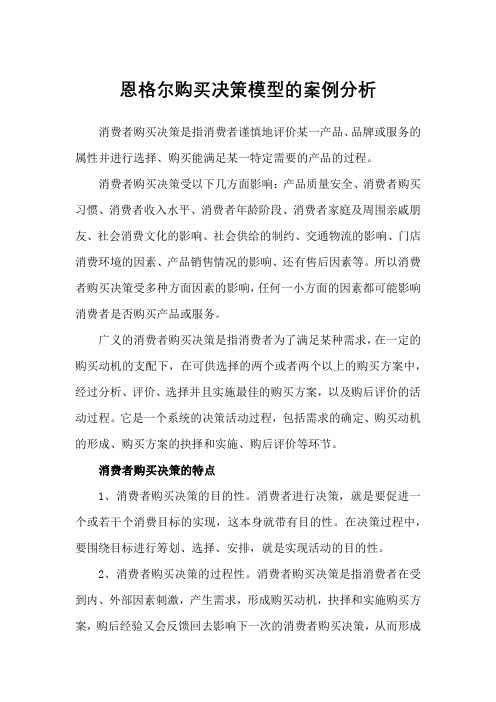
恩格尔购买决策模型的案例分析消费者购买决策是指消费者谨慎地评价某一产品、品牌或服务的属性并进行选择、购买能满足某一特定需要的产品的过程。
消费者购买决策受以下几方面影响:产品质量安全、消费者购买习惯、消费者收入水平、消费者年龄阶段、消费者家庭及周围亲戚朋友、社会消费文化的影响、社会供给的制约、交通物流的影响、门店消费环境的因素、产品销售情况的影响、还有售后因素等。
所以消费者购买决策受多种方面因素的影响,任何一小方面的因素都可能影响消费者是否购买产品或服务。
广义的消费者购买决策是指消费者为了满足某种需求,在一定的购买动机的支配下,在可供选择的两个或者两个以上的购买方案中,经过分析、评价、选择并且实施最佳的购买方案,以及购后评价的活动过程。
它是一个系统的决策活动过程,包括需求的确定、购买动机的形成、购买方案的抉择和实施、购后评价等环节。
消费者购买决策的特点1、消费者购买决策的目的性。
消费者进行决策,就是要促进一个或若干个消费目标的实现,这本身就带有目的性。
在决策过程中,要围绕目标进行筹划、选择、安排,就是实现活动的目的性。
2、消费者购买决策的过程性。
消费者购买决策是指消费者在受到内、外部因素刺激,产生需求,形成购买动机,抉择和实施购买方案,购后经验又会反馈回去影响下一次的消费者购买决策,从而形成一个完整的循环过程。
3、消费者购买决策主体的需求个性。
由于购买商品行为是消费者主观需求、意愿的外在体现,受许多客观因素的影响。
除集体消费之外,个体消费者的购买决策一般都是由消费者个人单独进行的。
随着消费者支付水平的提高,购买行为中独立决策特点将越来越明显。
4、消费者购买决策的复杂性。
心理活动和购买决策过程的复杂性。
决策是人大脑复杂思维活动的产物。
消费者在做决策时不仅要开展感觉、知觉、注意、记忆等一系列心理活动,还必须进行分析、推理、判断等一系列思维活动,并且要计算费用支出与可能带来的各种利益。
因此,消费者的购买决策过程一般是比较复杂的。
竞品分析报告中的五力模型分析
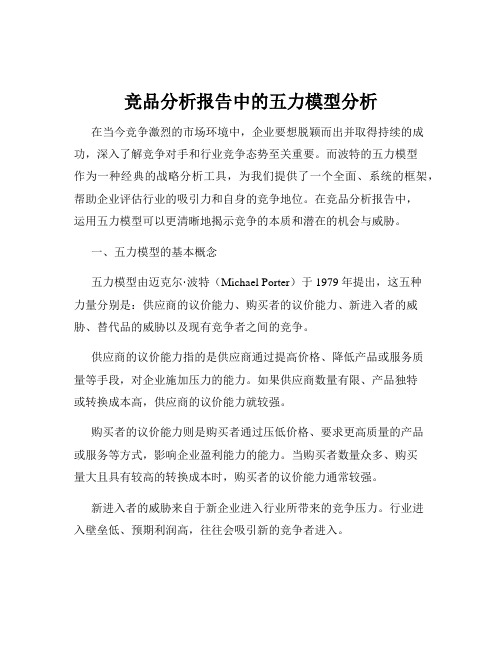
竞品分析报告中的五力模型分析在当今竞争激烈的市场环境中,企业要想脱颖而出并取得持续的成功,深入了解竞争对手和行业竞争态势至关重要。
而波特的五力模型作为一种经典的战略分析工具,为我们提供了一个全面、系统的框架,帮助企业评估行业的吸引力和自身的竞争地位。
在竞品分析报告中,运用五力模型可以更清晰地揭示竞争的本质和潜在的机会与威胁。
一、五力模型的基本概念五力模型由迈克尔·波特(Michael Porter)于 1979 年提出,这五种力量分别是:供应商的议价能力、购买者的议价能力、新进入者的威胁、替代品的威胁以及现有竞争者之间的竞争。
供应商的议价能力指的是供应商通过提高价格、降低产品或服务质量等手段,对企业施加压力的能力。
如果供应商数量有限、产品独特或转换成本高,供应商的议价能力就较强。
购买者的议价能力则是购买者通过压低价格、要求更高质量的产品或服务等方式,影响企业盈利能力的能力。
当购买者数量众多、购买量大且具有较高的转换成本时,购买者的议价能力通常较强。
新进入者的威胁来自于新企业进入行业所带来的竞争压力。
行业进入壁垒低、预期利润高,往往会吸引新的竞争者进入。
替代品的威胁源于能够满足相同或类似需求的其他产品或服务的存在。
替代品性价比越高,对现有产品的威胁就越大。
现有竞争者之间的竞争程度取决于竞争者的数量、规模、市场份额、产品差异化程度等因素。
竞争越激烈,企业的利润空间可能就越小。
二、供应商的议价能力分析在分析供应商的议价能力时,需要考虑多个方面。
首先是供应商的集中程度,如果供应商数量较少且相对集中,他们在价格、交货期、质量等方面就更有话语权。
例如,在芯片行业,少数几家大型供应商如台积电、三星等掌握着先进的制造技术,使得它们对下游企业具有较强的议价能力。
其次,供应商提供的产品或服务的独特性也会影响其议价能力。
若供应商提供的产品或服务是独一无二的,或者具有难以替代的技术优势,那么企业在采购时的选择余地就较小,供应商的议价能力就会增强。
11种全球著名商业分析模型史上最全总结!

11种全球著名商业分析模型史上最全总结!前言:这些商业分析模型被全球著名咨询公司早先广泛应用于很多行业的战略制定,有些已经old-fashioned,但大多的逻辑还在起作用。
无论是国内还是国际,无论是提供产品还是提供服务,是企业必备的战略制定参考手册。
1、波特五种竞争力分析模型被广泛应用于很多行业的战略制定波特的五种竞争力分析模型被广泛应用于很多行业的战略制定。
波特认为在任何行业中,无论是国内还是国际,无论是提供产品还是提供服务,竞争的规则都包括在五种竞争力量内。
这五种竞争力就是企业间的竞争、潜在新竞争者的进入、潜在替代品的开发、供应商的议价能力、购买者的议价能力。
这五种竞争力量决定了企业的盈利能力和水平。
竞争对手企业间的竞争是五种力量中最主要的一种。
只有那些比竞争对手的战略更具优势的战略才可能获得成功。
为此,公司必须在市场、价格、质量、产量、功能、服务、研发等方面建立自己的核心竞争优势。
影响行业内企业竞争的因素有:产业增加、固定(存储)成本/附加价值周期性生产过剩、产品差异、商标专有、转换成本、集中与平衡、信息复杂性、竞争者的多样性、公司的风险、退出壁垒等。
新进入者企业必须对新的市场进入者保持足够的警惕,他们的存在将使企业做出相应的反应,而这样又不可避免地需要公司投入相应的资源。
影响潜在新竞争者进入的因素有:经济规模、专卖产品的差别、商标专有、资本需求、分销渠道、绝对成本优势、政府政策、行业内企业的预期反击等。
购买者当用户分布集中、规模较大或大批量购货时,他们的议价能力将成为影响产业竞争强度的一个主要因素。
决定购买者力量的因素又:买方的集中程度相对于企业的集中程度、买方的数量、买方转换成本相对企业转换成本、买方信息、后向整合能力、替代品、克服危机的能力、价格/购买总量、产品差异、品牌专有、质量/性能影响、买方利润、决策者的激励。
替代产品在很多产业,企业会与其他产业生产替代品的公司开展直接或间接的斗争。
五力模型分析康师傅方便面

二、现有行业竞争者的威胁
• 1、识别现有竞争者 、
据业内统计,中国现有的300多家方便面生产企业中,有 实力的企业只有15家,竞争仍只集中在低端市场,而且集 中度非常高,仅康师傅和统一两个品牌就占据了整个市场 份额的60%。目前东南亚地区的方便生产商主要来自以下 几个国家和地区: 中国:今麦郎(河北)、隆尧中旺、白象(河南)、 )、隆尧中旺 )、国 中国:今麦郎(河北)、隆尧中旺、白象(河南)、国 河南)、斯美特(河南)、华丰、五谷道场、 )、斯美特 )、华丰 华(河南)、斯美特(河南)、华丰、五谷道场、福满多 台湾:顶新国际集团(康师傅、福满多)、 )、统一集团 台湾:顶新国际集团(康师傅、福满多)、统一集团 韩国: 韩国:农心集团 日本: 日本:日本日清食品株式会社
• 2、买方市场,行业产品供过于求 、买方市场,
由于进入市场的技术壁垒和资金壁垒都比较低, 使得这个市场涌入了大量的竞争者,市场竞争非 常激烈。
• 3、品牌消费时代的到来 、
4、消费水平不断提高,价格敏感 、消费水平不断提高, 程度下降
小结
• 综合以上分析,可以看出,产品的差异化 小,品牌转换壁垒低,买方市场,品牌消 费时代的到来,这一切强化了购买者讨价 还价的能力,有可能降低价格,要求高质 的产品和更多优质的服务,其结果是行业 竞争者们互相竞争残杀,导致行业利润下 降。
潜在进入者的威胁
• 1、行业状况分析 、
(1)产业发展前景广阔
方便面因具有方便、安全、美味、优质、价廉等5大特征,自1958年 问世以来,经过48年的发展,已成为全球仅次于面包的第二大主食产 品。 2005年,我国共生产方便面460亿包,产值达326亿元。
(2)产业壁垒小
方便面行业技术含量不高,进入壁垒较低;同时资金壁垒也比较低, 需求投入的启动资金要求不高。较低技术壁垒和资金壁垒,使得这个 有限的市场一时间涌入大量的竞争者,共同瓜分这个日渐饱和的市场。
用品牌或产品“黏性”来细分市场――转换模型与应用实例
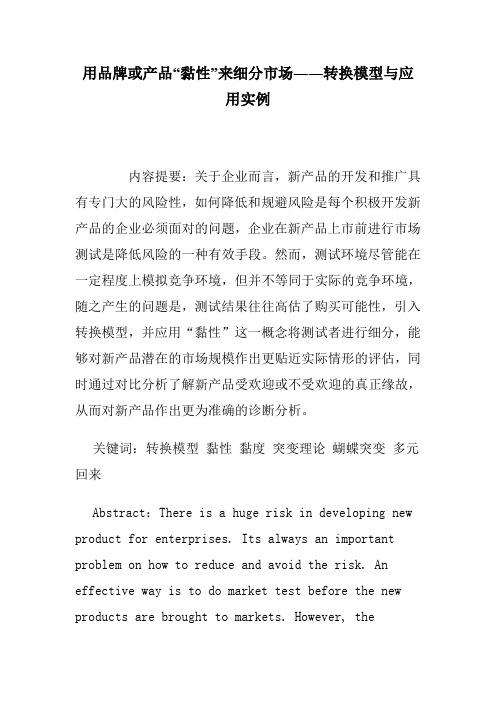
用品牌或产品“黏性”来细分市场――转换模型与应用实例内容提要:关于企业而言,新产品的开发和推广具有专门大的风险性,如何降低和规避风险是每个积极开发新产品的企业必须面对的问题,企业在新产品上市前进行市场测试是降低风险的一种有效手段。
然而,测试环境尽管能在一定程度上模拟竞争环境,但并不等同于实际的竞争环境,随之产生的问题是,测试结果往往高估了购买可能性,引入转换模型,并应用“黏性”这一概念将测试者进行细分,能够对新产品潜在的市场规模作出更贴近实际情形的评估,同时通过对比分析了解新产品受欢迎或不受欢迎的真正缘故,从而对新产品作出更为准确的诊断分析。
关键词:转换模型黏性黏度突变理论蝴蝶突变多元回来Abstract:There is a huge risk in developing new product for enterprises. Its always an important problem on how to reduce and avoid the risk. An effective way is to do market test before the new products are brought to markets. However, theenvironment of market test is not equal to that of competition even it can imitate that in some ways. So, the result of market test would often be overestimated.A more realistic evaluation on potential market scale could be made by introducing conversion model and the notion of "commitment". In the same time, by finding out the true reasons that the products are welcomed or not, a more precise diagnosis analysis on new product could be given by contrast analysis.一、背景简介自从美国市场营销学教授温德尔.史密斯于1956年第一提出市场细分理论以来,这一理论已被广泛用来指导企业的市场营销活动。
波特五力模型案例

用波特的“五力”模型分析耐克和阿迪达斯两大运动品牌一、美国运动鞋市场基本状况迈克尔·波特在其经典著作竞争战略中,提出了行业结构分析模型,即所谓的“5力模型”,他认为:行业现有的竞争状况、供应商的议价能力、客户的议价能力、替代产品或服务的威胁、新进入者的威胁这5大竞争驱动力,决定了企业的盈利能力。
从这5种力量的作用,分析美国运动鞋企业的竞争状态。
1、存在较高的进入壁垒。
美国运动鞋产业是由“没有工厂”的品牌型公司组成,大公司在产品设计与开发、产品广告与销售网络、出口方面更具有竞争优势。
更重要的是,品牌个性与消费者忠诚度都给潜在的进入者设置了无形的屏障。
2、供应商的议价能力较弱。
因为大多数运动鞋产业的投入都是同质的,特别是在耐克发起了外购浪潮后,超过90%的生产都集中在低工资、劳动力远远供过于求的国家。
3、购买者,运动鞋的终端消费比较在意价格,同时对时尚潮流更加敏感,但是对于公司的利润率并没有极为负面的影响。
因为如果存在利润的减少,那么这将通过降低在发展中国家的生产来弥补。
此外,大多数品牌在产品差异化方面很成功,这阻止了购买者将品牌同不断转换的品牌形象联系起来。
4、由于其他鞋类都不适宜运动,所以现在还没有运动鞋类的完全替代产品。
5、美国运动鞋市场已饱和,充满激烈的竞争且增长缓慢,因此对于新进入者只有很小的空间。
耐克、阿迪达斯和锐步,这些主要品牌抢占了超过一半的市场份额并保持相对稳定。
通过以上分析,我们可以看到:1、这是一个令人垂涎的市场,但行业壁垒高筑,有较低的供应商议价能力;适度的购买者议价能力;没有知名品牌的替代产品。
2、在高度市场集中,还没有出现垄断时,市场的对抗十分激烈。
因此,在这种竞争环境中,企业保持市场份额与盈利,主要依靠他们的市场竞争策略。
二、耐克和阿迪达斯市场地位的分析(一)耐克的领导地位耐克起源于1962年,由菲尔·耐特首创,当时命名为“蓝丝带体育”,20世纪70年代正式更名为Nike,在美国运动鞋业内坐头把交椅,1980年占据约50%的美国市场份额。
五种力量模型分析简介

产业 竞争者
买方的侃价能力
买方
决定供方力量的因素
替代品的威胁
•投入的差异
•产业中供方和企业的转换成本 •替代品投入的现状
替代品
•供方的集中程度
•批量大小对供方的重要性
•与产业总购买量相关的成本
•投入对成本和特色的影响
决定替代威胁的因素
•产业中企业前后整合相对于后向 •替代品相对价格表现
整合的威胁
•转换成本
处于下一阶段的竞争对手
土地的拥有者和 使用者
政府、欲搬迁 的工厂、拆迁户
企业间竞争
与自己处于同一阶段 和前一阶段的竞争对手
房屋购买者
消费者
替代品
普通商品房、经适房的开发商
A
10
➢ 对上述五种竞争压力做进一步分析,剔除某些不重要的或者是现阶段 不重要的因素
土地供给
•城镇征地 •搬迁 •拆迁 •教育用地
五种力量模型分析
一、竞争环境的结构性分析 二、五力模型及其解释 三、五力模型的运用
A
1
一、竞争环境的结构性分析
竞争战略选择的两个中心问题
➢ 产业的潜力如何?由产业长期盈利能力 Nhomakorabea其影响因素所决定的产 业吸引力。
➢ 企业在产业内的竞争地位如何?明确影响企业在产业内相对竞争 地位的因素。
迈克尔.波特
•绝对成本优势
➢ 研究曲线专有 ➢必要的投入渠道
潜在入侵者
➢低成本产品设计专有
•政府政策 •预期的报复
新进入者的威胁
竞争的决定因素
•产业增长 •固定成本/附加价值 •周期性生产过剩 •产品差异 •商标专有 •转换成本 •集中与平衡 •信息的复杂性 •竞争者的多样性 •公司风险 •退出壁垒
真维斯的SWOT分析模型和五力分析模型

真维斯的SWOT分析模型和五力分析模型12营销1班高易峰真维斯的SWOT分析模型简介:真维斯(JEANSWEST)1972年成立于澳大利亚。
1990年,旭日收购了澳大利亚休闲服饰品牌JeansWest,成立了旭日集团下属的真维斯国际(香港)有限公司。
1993年才开始在上海一炮打响的真维斯,如今在全国已经有700多家连锁店和加盟店。
这家总部设在惠州的休闲装生产企业,在一线城市真维斯的专卖店开的不算密集,但是光顾的人群比较年轻化。
这么多年,真维斯这个品牌的消费群体一直停在中学生的档次,并没有随着第一批消费者的年纪增长而增加新的设计风格和成熟路线的产品。
也正因为如此,真维斯根不上越来越具有消费能力的一群人的眼光,只能渐渐沦落到小地方。
沦落成三四线城市的抢手货!真维斯品牌内部优势:1.真维斯名牌大众化、渗透度高,产品价格实惠,稳占休闲装市场的领袖地位。
真维斯是以广大年轻人设计的对象,将每季最新的潮流元素融入服装当中,以易穿易配搭的款式来吸引顾客。
多年来,真维斯以大众潮流的休闲风格,深受年轻人的喜爱,已成为年轻一代的时尚必需品。
2.真维斯多年来热心公益事业,体现了良好的企业文化。
在积极为社会创造财富的同时,真维斯以真诚回馈社会的方式获得了广大消费者的的认可,也使更多人了解了真维斯。
真维斯一直致力于公益慈善事业,秉承“穷则独善其身,达则兼善天下”的核心企业价值观。
捐建了30多所“真维斯希望小学”。
携手希望工程成立“真维斯大学生助学基金”,帮助家庭贫困的农村大学生完成大学学业,迄今这一助学基金总额度高达1800万元。
积极响应“圆梦行动”,举办真维斯“爱心岗位助千名学子上大学”活动,为1000多名贫困大学生提供在真维斯店铺工作的机会,并捐资300万元设立“真维斯希望教师基金”改善贫困地区的师资力量。
捐款资助过“助学长征”、“希望小学运动会”和“希望小学歌咏大赛”等专项公益活动。
3.真维斯的品牌管理策略是将资源放在提升产品质量上面,力求以质量取胜,用这种更直接的回馈方式来让顾客受惠。
(完整word版)CBBE模型(品牌价值模型)
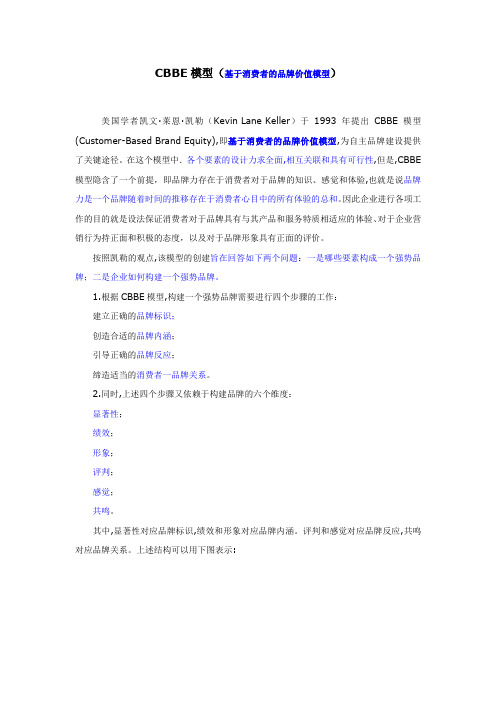
CBBE模型(基于消费者的品牌价值模型)美国学者凯文·莱恩·凯勒(Kevin Lane Keller)于1993年提出CBBE模型(Customer-Based Brand Equity),即基于消费者的品牌价值模型,为自主品牌建设提供了关键途径。
在这个模型中.各个要素的设计力求全面,相互关联和具有可行性,但是,CBBE 模型隐含了一个前提,即品牌力存在于消费者对于品牌的知识、感觉和体验,也就是说品牌力是一个品牌随着时间的推移存在于消费者心目中的所有体验的总和。
因此企业进行各项工作的目的就是设法保证消费者对于品牌具有与其产品和服务特质相适应的体验、对于企业营销行为持正面和积极的态度,以及对于品牌形象具有正面的评价。
按照凯勒的观点,该模型的创建旨在回答如下两个问题:一是哪些要素构成一个强势品牌;二是企业如何构建一个强势品牌。
1.根据CBBE模型,构建一个强势品牌需要进行四个步骤的工作:建立正确的品牌标识;创造合适的品牌内涵;引导正确的品牌反应;缔造适当的消费者一品牌关系。
2.同时,上述四个步骤又依赖于构建品牌的六个维度:显著性;绩效;形象;评判;感觉;共鸣。
其中,显著性对应品牌标识,绩效和形象对应品牌内涵。
评判和感觉对应品牌反应,共鸣对应品牌关系。
上述结构可以用下图表示:CBBE模型的构成要素在CBBE模型中,构建强势品牌的四个工作步骤又细分成一系列的相关要素:1.建立正确的品牌标识需要创建基于消费者的品牌显著性品牌显著性又与如下问题紧密关联,比如该品牌在各种场合下能够被消费者提及的频率和难易程度,该品牌在多大程度上能够被消费者轻易认出,哪些关联因素是必要的,该品牌的知晓度有多少说服力等等。
区分品牌显著性的关键维度是品牌深度和品牌宽度,品牌深度指的是品牌被消费者认出的容易程度;品牌宽度则指当消费者想起该品牌时的购买范围和消费状况一个高度显著的品牌能够使消费者充分购买并在可选择范围内总是想起该品牌。
产品经理-6种转化率分析模型,提高产品转化率、用户体验

6种转化率分析模型,提高产品转化率、用户体验在微观层面(实战方法论)通过6种转化率分析模型不断提高产品转化率、用户体验;大家如果能掌握好增长方法论和降低转化的秘诀,就一定可以通过实现业务快速增长。
本文根据谢荣生在起点学院公开课分享的课程整理而成,加入起点学院在线社员到浏览器中详细了解),即可观看本选修视频回放及尊享300门视频预科学习特权。
1.1流量红利渐失,竞争日益激烈目前新平台、新应用发展起来的难度比十年软件系统前要难数十倍,主要有三方面的原因:根据CNNIC统计报告显示:2006年网民增长率为23.4%,2021年网民增长率为6.1%,并且持续在下降。
而在增量流量降低的同时,网络流量集中度在显著提高,以BAT为核心的大型互联网平台占据了内80%的流量。
每次因特网应用潮浪潮来临时,全国都有数千家同类可同电子商务平台进行竞争,经过3-5年竞争落幕时,仅剩下排名前3的平台脱颖而出,惨重程度可想而知。
1.2转化率对于企业和产品经理、运营人员的意义转化率是已经完成转化目标的用户占人口比例总体用户的比例,注册、下单、登录、复购,都可以用转化率进行量化,转化率是互联网平台的高速增长的电子商务平台基石。
高高增长的平台基本也是高转化率的平台,而增长水平影响了企业的市场占有率和价值,对于在企业中工作的从业人员看来,高增长的企业也会更快促进个人的成长,获得更高额的回报。
提升转化率是全员参与的行为,企业中的高管、中层、基层都必须掌握相应的方法,我们可以通过三个层面提升探讨如何共同转化率实现业务增长,这就是:取势、明道、优术。
此六字出自老子所著《道德经》,被李嘉诚先生题为长江商学院的校训:取势,远见也;明道,真知也;优术,实效也。
取势为要,明道其次,优术第三,以下我们从这三个层面详细解读具体的方法:2.1提升转化率方法论之:取势“势”往往无形,却确定了方向;“取势”重在顺势而为,顺势则事半功倍。
也就是说,雷军所说的成为风口上的猪;以下方法论中的鱼塘理论、机会井理论、PMF帮助我们“取势”。
品牌转换模型ProductQuest

Output - Control Chart
Probability of preference
ProductQuest®
Product Life Cycle
Evaluation
Feasibility
Tracking
Maturity
Feasibility Stage
Product Feasibility
Early evaluation of prototype products Identify opportunities, understand risks of product weaknesses, provide R&D with improvement direction Explore categories for opportunities
Influence of
31.6
48.8
19.6
46.4
18.9
34.7
23.6
41.1
35.3
34
11.1
54.9
21.9
33.6
44.5
15.9
21
63.1
33.8
36.5
29.7
42.2
32.3
25.5
43.5
20.4
36.1
34.5
35.4
30.1
55.7
17.7
26.6
Sweetness
Richness Strength of coffee flavour
1
Overall liking
7.48
8.51
6.97
8
6.37 5.6
7.98 7.79
美特斯邦威波特五力模型分析

产品差异
工艺设备 技术水平
生产高质量、 生产高质量、高档次的服装需要先进的工艺设 备和专业技术,这就需要大量的资本投入、人力投 这就需要大量的资本投入、 入和大量技术熟练的员工, 入和大量技术熟练的员工,本行业新进入者短时间 内难以达到。 内难以达到。
服装行业进入壁垒分析→ 服装行业进入壁垒分析→潜在入侵者分析
2、产品差异之森马
“中国驰名商标”、“中国名牌”、“国 中国驰名商标” 中国名牌” 家免检产品”三大桂冠,是中国消费者最 家免检产品”
喜爱的品牌;巴拉巴拉童装也荣获“ 喜爱的品牌;巴拉巴拉童装也荣获“中国 十大童装品牌” 中国名牌”产品称号。 十大童装品牌”和“中国名牌”产品称号。 森马集团相继被授予温州市活力和谐 企业、全国模范劳动关系和谐企业等殊荣, 企业、全国模范劳动关系和谐企业等殊荣,
以快速、平价、时尚的市场定位和大 以快速、平价、 众时尚的经营理念,深受广大消费者的青 众时尚的经营理念, 睐和喜爱。 睐和喜爱。
产业竞争者分析
唐狮服饰隶属于博洋集团, 唐狮服饰隶属于博洋集团,集团位于 浙江宁波,是集团服饰系中主导品牌之一, 浙江宁波,是集团服饰系中主导品牌之一, 集团成立于1994 1994年 主要经营面料、 集团成立于1994年,主要经营面料、家用 纺织品、服装等的制造与贸易。 纺织品、服装等的制造与贸易。
分销渠道是服装企业的生存基础, 分销渠道是服装企业的生存基础,是其赢得市场和消费 者的根本,是其建立良好品牌的关键。 分销渠道 者的根本,是其建立良好品牌的关键。然而打造具有深度和 广度的分销渠道需要大量的资金投入, 广度的分销渠道需要大量的资金投入,需要大量的人力和物 力,需要卓越的组织和管理能力,本行业的新进入者短时间 很难获得所需的资金、 内很难获得所需的资金、人力和物力等条件。
十一种全球著名的商业分析模型课件

企业间的竞争
影响因素
9
企业间的竞争
能够建立核心竞争优势 的点
市场、价格、质量、产量、 功能、服务、研发等
10
潜在新竞争者的进入
影响因素
经济规模 专卖产品的差别 商标专有 资本需求 分销渠道 绝对成本优势 政府政策 行业内企业的预期反击
11
潜在替代品的开发
决定因素
替代品的相对价格表现 转换成本 客户对替代品的使用倾向
49
4. 差异化战略
价格相同/略高于竞争对手+提供可 感受的附加值
50
可采取的 差异化类 型
有形差异化 外观、质量、功能的独特性
无形差异化 服务质量、客服、品牌、文化
51
5. 集中差异化战略
01
特别高的价格+更高的产品附加 值
02 只能在特定的细分市场中经营和竞争
52
6.7.8 高价撇脂战略(失败战略)
十一种全球著名的商业 分析模型
1
01
波特五种竞争力分析模型
2
波特五种竞争力分析模型
01
应用场景
02
波特五力 分析模型
03
五种竞争 力
3
波特五种竞争力分析模型
应用场景
01
分析企业盈 利能力和水
平
02
制定未来战 略
4
应用场景
01分析企业
盈利能力 和水平
02制定未来
战略
5
波特五种竞争力分析模型
五种竞争力
”
58
08
GE行业吸引力矩阵
59
GE行业吸引力矩阵
01
应用场 景
02
GE行 业矩阵
03
- 1、下载文档前请自行甄别文档内容的完整性,平台不提供额外的编辑、内容补充、找答案等附加服务。
- 2、"仅部分预览"的文档,不可在线预览部分如存在完整性等问题,可反馈申请退款(可完整预览的文档不适用该条件!)。
- 3、如文档侵犯您的权益,请联系客服反馈,我们会尽快为您处理(人工客服工作时间:9:00-18:30)。
Output - Product Profile
Weight Overall liking Cocoa aroma 0.87 Cocoa flavour 0.77 Malt/Cereal aroma -0.67 Creamy texture 0.62 Bitter aftertaste -0.62 Astringent aftertaste -0.62 Sweet flavour 0.53 Soy aftertaste -0.50 Dairy/Milky aroma 0.23 Coffee flavour 0.12 Roasted aroma 0.11 Mouthcoat aftertaste 0.10
Output - Perceptual map
Evaluation Stage
ed products vs. competitors Fine-tuning product to optimum level prior to launch Can include other marketing components - concept, pack, price, etc => Fine-tuning marketing mix prior to launch
72
5 -1.3 Too strong
Creaminess Not enough -1.4 18
74
9 -0.8 Too much
Consistency Not enough -1.0 15
79
6 -1.7 Too smooth
Output - Potential Modeling
Overall liking
Output - Control Chart
Output - Perceptual Map
Change over time
Maturity Stage
Product Maturity
Assess cost reduction opportunities increase profit Measure product preference - sales declining Ingredient substitution = consumer retention Gauge how much product change and ingredient change is possible
PAIRED COMPARISON
Richness Too weak -1.9 18
72
11 -1.4 Too strong
Colour Too light -1.9 6
84
10 -1.2 Too dark
Strength of coffee flavour Too weak -1.2 43
55
3 -1.5 Too strong
Roast taste Too weak -1.0 23
A is too sweet, too weak in coffee flavour and
too weak in roast taste
Penalty %
Product A
% Just Right
% Penalty
Sweetness Too weak -2.1 7
68
26 -1.1 Too strong
Output - Product Profile
Overall liking Sweetness Richness Colour
Strength of coffee flavour Roast taste Creaminess
Consistency
Output - Penalty Analysis
Output Options
TRIANGLE TEST
N=150
DUO-TRIO TEST
REFERENCE SAMPLE RB
PRODUCT A
PRODUCT B
Significant 95% confidence level
There is significant (with 95% confidence) discrimination
A B C D E F G H I J K
Influence of
Products A and B have the most potential
Tracking Stage
Product Tracking
Monitor products - attribute quality, brand preference Track health and equity of product, assess changes in competitors, measure product variation against internal quality control standards Is product manufactured at a consistently acceptable standard?
品牌转换模型分析
2020年4月24日星期五
Product Life Cycle
Evaluation
Feasibility
Tracking
Maturity
Feasibility Stage
Product Feasibility
Early evaluation of prototype products Identify opportunities, understand risks of product weaknesses, provide R&D with improvement direction Explore categories for opportunities
